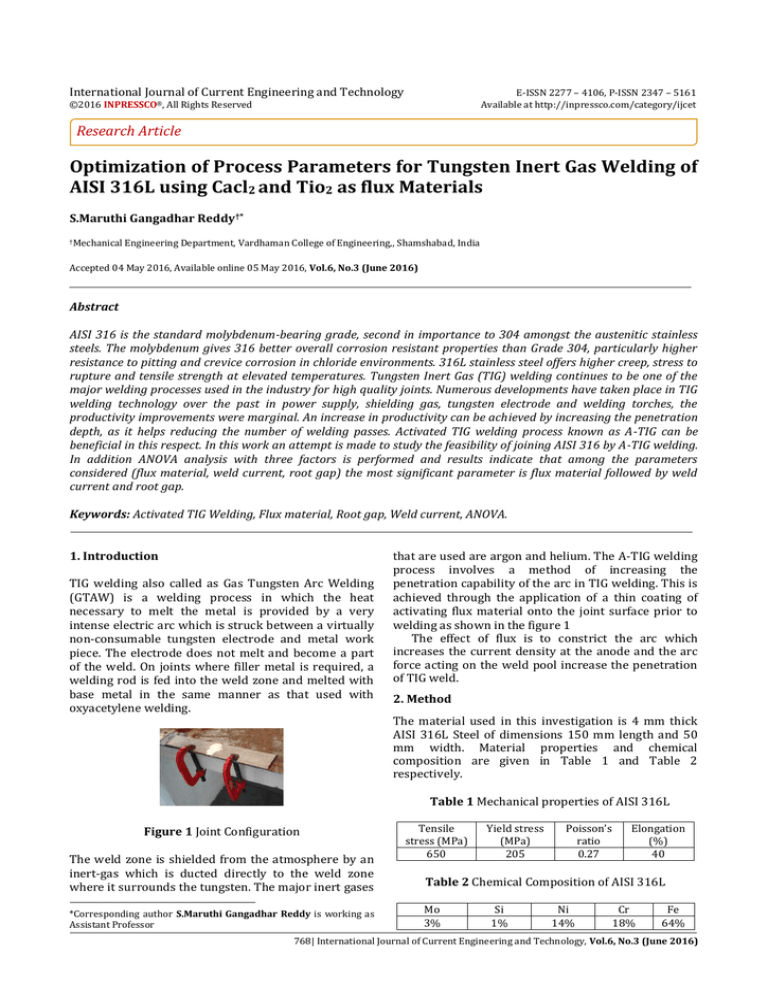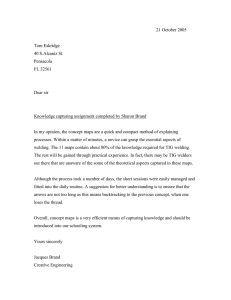
International Journal of Current Engineering and Technology
E-ISSN 2277 – 4106, P-ISSN 2347 – 5161
Available at http://inpressco.com/category/ijcet
©2016 INPRESSCO®, All Rights Reserved
Research Article
Optimization of Process Parameters for Tungsten Inert Gas Welding of
AISI 316L using Cacl2 and Tio2 as flux Materials
S.Maruthi Gangadhar Reddy†*
†Mechanical
Engineering Department, Vardhaman College of Engineering,, Shamshabad, India
Accepted 04 May 2016, Available online 05 May 2016, Vol.6, No.3 (June 2016)
Abstract
AISI 316 is the standard molybdenum-bearing grade, second in importance to 304 amongst the austenitic stainless
steels. The molybdenum gives 316 better overall corrosion resistant properties than Grade 304, particularly higher
resistance to pitting and crevice corrosion in chloride environments. 316L stainless steel offers higher creep, stress to
rupture and tensile strength at elevated temperatures. Tungsten Inert Gas (TIG) welding continues to be one of the
major welding processes used in the industry for high quality joints. Numerous developments have taken place in TIG
welding technology over the past in power supply, shielding gas, tungsten electrode and welding torches, the
productivity improvements were marginal. An increase in productivity can be achieved by increasing the penetration
depth, as it helps reducing the number of welding passes. Activated TIG welding process known as A-TIG can be
beneficial in this respect. In this work an attempt is made to study the feasibility of joining AISI 316 by A-TIG welding.
In addition ANOVA analysis with three factors is performed and results indicate that among the parameters
considered (flux material, weld current, root gap) the most significant parameter is flux material followed by weld
current and root gap.
Keywords: Activated TIG Welding, Flux material, Root gap, Weld current, ANOVA.
1. Introduction
1 TIG
welding also called as Gas Tungsten Arc Welding
(GTAW) is a welding process in which the heat
necessary to melt the metal is provided by a very
intense electric arc which is struck between a virtually
non-consumable tungsten electrode and metal work
piece. The electrode does not melt and become a part
of the weld. On joints where filler metal is required, a
welding rod is fed into the weld zone and melted with
base metal in the same manner as that used with
oxyacetylene welding.
that are used are argon and helium. The A-TIG welding
process involves a method of increasing the
penetration capability of the arc in TIG welding. This is
achieved through the application of a thin coating of
activating flux material onto the joint surface prior to
welding as shown in the figure 1
The effect of flux is to constrict the arc which
increases the current density at the anode and the arc
force acting on the weld pool increase the penetration
of TIG weld.
2. Method
The material used in this investigation is 4 mm thick
AISI 316L Steel of dimensions 150 mm length and 50
mm width. Material properties and chemical
composition are given in Table 1 and Table 2
respectively.
Table 1 Mechanical properties of AISI 316L
Figure 1 Joint Configuration
The weld zone is shielded from the atmosphere by an
inert-gas which is ducted directly to the weld zone
where it surrounds the tungsten. The major inert gases
*Corresponding author S.Maruthi Gangadhar Reddy is working as
Assistant Professor
Tensile
stress (MPa)
650
Yield stress
(MPa)
205
Poisson’s
ratio
0.27
Elongation
(%)
40
Table 2 Chemical Composition of AISI 316L
Mo
3%
Si
1%
Ni
14%
Cr
18%
Fe
64%
768| International Journal of Current Engineering and Technology, Vol.6, No.3 (June 2016)
S.Maruthi Gangadhar Reddy
Optimization of Process Parameters for Tungsten Inert Gas Welding of AISI 316L..
Three process parameters Flux material, Weld current,
Root gap which influence the Activated TIG welded
joints, were selected for this study. This paper, by using
full factorial experimental design (23) with taguchi’s
design concept, analyses the effect of Flux material,
Weld current and Root gap for optimum tensile
strength.
Table 3 process parameters with their two levels
Process parameters
Flux Material
Weld Current
Root Gap
Level 1
Cacl2
100 A
0 mm
Level 2
Tio2
150 A
1 mm
The initial joint configuration was obtained by securing
the plates in the position using the mechanical clamps.
Flux is applied on the joint using a brush. Welding is
carried by using Zogo TIG 200 machine having
tungsten electrode of 2 mm diameter on all the
specimens by altering levels of the process parameters.
Tensile test specimens prepared as per ASTM E8M- 04
standard.
Graph 1 Main effects plot for S/N Ratios
Level
Flux
Material
1
2
Delta
Rank
325.3
481.8
156.5
1
Weld Current
(Amps)
Root Gap
(mm)
353.8
453.3
99.5
2
369.0
438.0
69.0
3
3. Results
The experimental results for tensile strength were
given in table 4.
Table 4 Experiment values of Tensile strength
S/N
Ratio
dB
49.4258
46.7691
49.0050
55.8338
53.9096
49.2779
52.0845
55.9037
Means
In taguhi method the S/N ratio is used to measure the
quality characteristic deviating from the desired value.
In this study, S/N ratio was chosen according to the
criterion large – the – better, in order to maximize
response.
1
1
(1)
S / N 10 log
n y2
Graph 2 Main effects plot for S/N Ratios
The experimental results were analyzed with the
analysis of variance (ANOVA), which is used to
investigate which design parameter significantly affect
the characteristic. The contributions of input
parameters on tensile strength are identified by
ANOVA. Table 7 shows the ANOVA results for tensile
strength.
Table 7 ANOVA result for tensile strength
Where n is the number of measurements and y is the
desired value in a run. The S/N ratio values calculated
by taking (1) into consideration were listed in Table 4
for tensile strength
Source
Table 5 Response table for S/N Ratios
Flux Material
Level
Flux
Material
1
2
Delta
Rank
49.85
53.21
3.36
1
Weld Current
(Amps)
Root Gap
(mm)
50.26
52.79
2.54
2
51.11
51.95
0.84
3
Weld Current
Root Gap
%
Contribution
296
218
282
619
496
291
402
624
F
Tensile
Strength
(Mpa)
296
218
282
619
496
291
402
624
Mean of
squares
Root
Gap
(mm)
0
1
0
1
0
1
0
1
Sum of
squares
Tio2
Tio2
Cacl2
Cacl2
Tio2
Tio2
Cacl2
Cacl2
Weld
current
(Amps)
100
100
100
100
150
150
150
150
Degrees of
freedom
Flux
Material
1
1
1
48985
19801
9522
48985
19801
9522
1.99
0.80
0.39
62.55
25.2
12.15
Conclusions
1) Flux material has been found dominant parameter
for tensile strength followed by weld current.
769| International Journal of Current Engineering and Technology, Vol.6, No.3 (June 2016)
S.Maruthi Gangadhar Reddy
Optimization of Process Parameters for Tungsten Inert Gas Welding of AISI 316L..
2) Root gap shows minimal effect on tensile strength
compared to other parameters.
3) The optimum weld condition is obtained while
using Cacl2 as activated flux material and at 150
Amp with 1 mm root gap.
References
V Kumar, Bill Lucas, D Howse, G Melton, S Raghunathan and
Louriel Vilarinho, Investigation of the A- TIG mechanism
and the productivity benefits in TIG welding, TWI Limited,
Cambridge, United Kingdom. Federal University of
Uberlandia, Brazil.
D S Howse and W Lukas(2000), An investigation into arc
constriction by active fluxes for TIG (A-TIG) welding,
Published in Science and Technology of Welding and
Joining, Vol.5, No.3, pp 189-193, by IOM communications
Ltd for The Institute of Materials.
A.B.Sambherao,(2013) Use of Activated Flux for Increasing
Penetration In Austenitic Stainless Steel While Performing
GTAW, International Journal of Emerging Technology and
Advanced Engineering,
M.Vasudevan, A.K.Bhanduri, and Baldev Ra(2005),
Microstructure and Mechanical Properties of Austenitic
Stainless Steels, International Welding Congress, Mumbai.
Akash.B.Patel, Prof.Satyam.P.Patel, The Effect of Activating
Flux in Tig Welding, International Journal of Computational
Engineering Research.
770| International Journal of Current Engineering and Technology, Vol.6, No.3 (June 2016)



